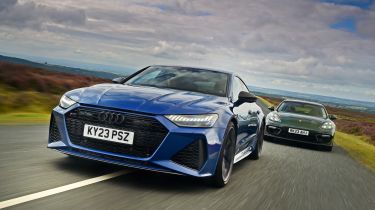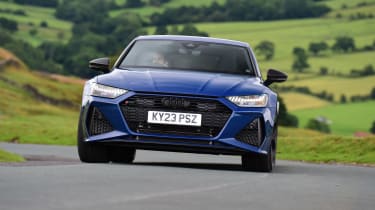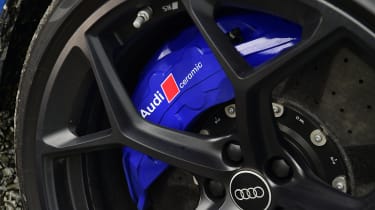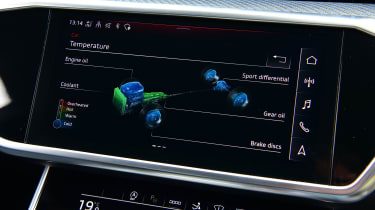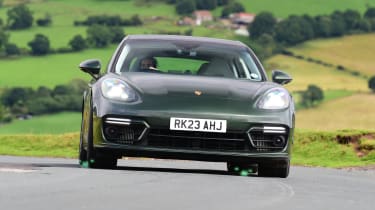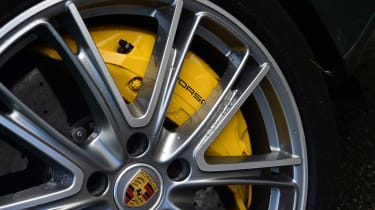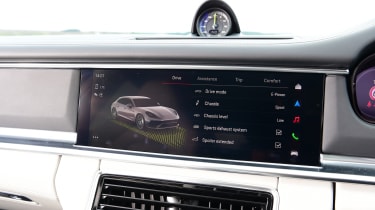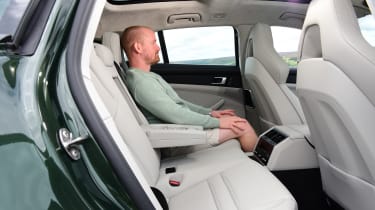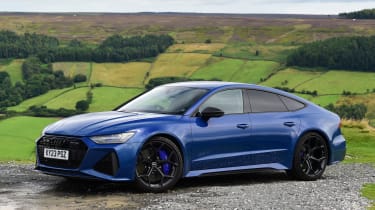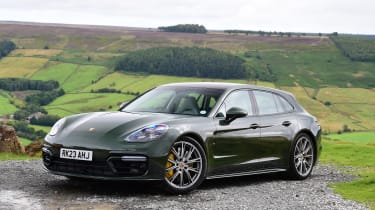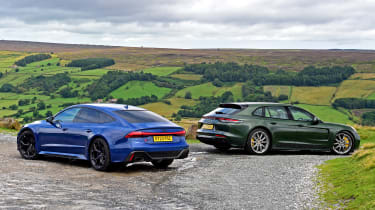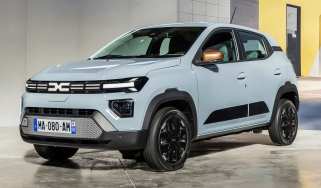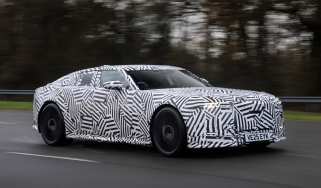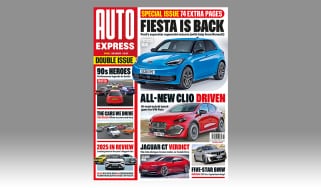Audi RS 7 Sportback vs Porsche Panamera: 2023 twin test review
Ultra-fast executive models from Audi and Porsche go head to head
It’s only a matter of time before the combustion-engined performance car is a thing of the past. As a result, some models are going out with a bang, while others will evolve with the times. These two approaches are represented in this test.
Audi’s RS 7 Sportback Performance is the hottest version yet of an already lighting-fast five seater, while the Porsche Panamera Turbo S E-Hybrid uses emissions-busting plug-in hybrid tech to deliver the goods.
Does electrical assistance add anything to the Porsche driving experience? Has Audi turned the RS 7 into something special? And which is the most complete package overall?
| Audi RS 7 Sportback performance Carbon Black | Porsche Panamera Turbo S E-Hybrid | |
| Price: | £127,495 | £145,900 |
| Powertrain: | 4.0-litre twin-turbo V8, 621bhp | 4.0-litre twin-turbo V8/e-motor, 691bhp |
| 0-62mph: | 3.4 seconds | 3.2 seconds |
| Test efficiency: | 24.1mpg / 5.3mpl | 26.3mpg / 5.8mpl |
| Official CO2 | 281g/km | 65g/km |
| Annual VED: | £560 | £560 |
Audi RS 7 Sportback
The new Performance model has replaced the standard RS 7 Sportback entirely, but it comes in the same three trim levels. In the Carbon Black spec we have here, it’s priced from £127,495.
Tech highlights
We can’t recall ever feeling that the RS 7 was short of power, but that hasn’t stopped Audi’s RS division from bolting on a pair of enlarged turbochargers in this Performance edition.
With boost pressure increased from 2.4 to 2.6 bar, the mild-hybrid 4.0-litre V8’s headline figures stand at 621bhp and 850Nm of torque – up 30bhp and 50Nm from before. The result is a 0-62mph time of 3.4 seconds, which is 0.2 seconds quicker than the outgoing RS 7.
Used - available now

2023 Hyundai
Tucson
23,000 milesAutomaticPetrol1.6L
Cash £24,995
2023 Hyundai
Bayon
33,230 milesAutomaticPetrol1.0L
Cash £13,995
2023 Hyundai
i20
24,480 milesManualPetrol1.0L
Cash £13,495
2022 Hyundai
Ioniq 5
53,946 milesAutomaticElectric
Cash £20,995Fine tuning to the car’s transmission control unit makes the eight-speed gearbox shift faster in its most aggressive settings, but it’s also smoother in its more relaxed modes. There are six driving modes to choose from, with configurable RS1 and RS2 modes accessible via a shortcut button on the steering wheel.
Chassis: Standard on all models is the RS Dynamics Package, which includes a 174mph limited top speed, four-wheel steering and a quattro sport differential on the rear axle. Our car features the Dynamics Package Plus, which raises the limiter to 189mph but also adds carbon-ceramic brake discs to scrub off all of that speed. The 440mm-diameter front and 370mm rear discs weigh 34kg less overall than the conventional steel discs.
Also reducing unsprung mass are new forged 22-inch alloy wheels fitted to the Carbon Black and Carbon Vorsprung models. These shave an additional 5kg per corner over the standard items.
Driving
Upgrades have transformed the Audi RS 7 from a car that was deeply effective but ultimately slightly aloof, to one that’s even quicker and more engaging than ever.
Around town: Despite its supercar-like performance, the RS 7 is no harder to drive at low speeds than a standard A7 Sportback. The ride is slightly on the firm side, but not to the point of being harsh or uncomfortable. The result is good road feel, with plenty of information about the surface reaching the driver. The four-wheel steering really helps low-speed manoeuvrability, too.
A & B-roads: Find a twistier section of road and the RS 7 really comes alive. The steering is quick – almost too fast – but once you’re dialled into its reactions, it makes this fast Audi feel so much more agile than a two-tonne five seater has any right to be.
It’s helped by superb damping, which means the platform remains composed, even when loaded up towards the end of its travel on a bumpy road. Grip is astounding, and that trick rear differential gives stunning traction out of corners, even when making the most of that astonishing power. But while it’s quick, it’s the heightened level of interaction from the chassis that really stands out.
The carbon-ceramic brakes deliver relentless stopping power. Audi has managed to engineer a reassuring feel under your foot – that’s not always the case with these high-end discs – so you always have confidence when driving enthusiastically.
Motorway: The ride is superb at high speeds, and the RS 7’s low, wide body gives phenomenal straight-line stability. Tyre roar is a little pronounced, but otherwise refinement is great.
Ownership
The Performance trim is singled out from previous RS 7 models thanks to subtle cosmetic changes. Beyond the wheels, the updates from the outside are limited to a matt-grey finish for the door mirrors, front spoiler, lower grille inserts, side sills, window trims and rear diffuser.
Inside, the transformation from standard A7 into RS 7 is fairly understated, too, but the key changes underpin its sporting appeal. Chief among those are the RS seats, which feature adjustable side bolsters and a honeycomb stitching effect in the centre panels. In our car, this was set off with blue highlights for the stitching, logos and seatbelts, matching the Ascari Blue exterior paint. Even the carbon-fibre trim inserts come with blue highlights. The steering wheel is flat bottomed, trimmed in Dinamica, and features a subtle RS logo at the base of the centre spoke.
The dashboard design is dominated by three digital displays. The shiny screens blend almost seamlessly into the gloss trim finishes around them, which results in a very cohesive, almost understated look. The fit and finish is excellent, and the driving position has plenty of adjustment.
A premium brand comes with high expectations from owners, and based on our most recent Driver Power survey, Audi has failed to live up to them. Of the 32 brands surveyed, it ranked 30th – only Fiat and MG scored lower – with ride, handling, practicality and value all coming in for criticism.
We would argue that the RS 7 is an outlier in those rankings, though; as we pointed out earlier, its chassis is one of this car’s strongest suits.
Storage: Deep door bins, a large glovebox and a small cubby beside the steering column are all useful storage features. In the centre console, a couple of cup-holders are hidden under a hinged door, while there’s also a shallow bin beneath the centre armrest.
Practicality
Given the performance that it has to offer, the RS 7 Sportback is a remarkably practical machine.
Rear seats: At almost two metres wide, the RS 7 has a broad cabin, which is really apparent when you sit in the back seats. The sculpted door panels provide plenty of elbow room, and the outer seats are heavily bolstered too, so they are very comfortable. Legroom is great, and despite the sloping roofline, the low-set seats mean there’s enough headroom for tall adults.
Boot space: The 523-litre boot has more than enough luggage space for four or five occupants. The hatchback opening offers easy access, even if the load lip is fairly high. Once you’ve got over that small hurdle, the load area is wide and square, so stacking items inside is easy.
What to buy?
Which engine and trim we’d choose
- Powertrain: There’s just the one engine to choose from here, but the character of that twin-turbo V8 means that you’ll want for little else.
- Trim: The standard RS 7 starts from £118,545, our Carbon Black test car is in the middle, while the top-spec Carbon Vorsprung comes to £135,945.
- Options: There are seven no-cost paints, crystal black is £1,650 and matte finishes are £6,000, or you can choose from an extended range of options for £4,500. The lightweight wheels are available in grey, gold or machined finishes for £250.
- Our choice: At this price point, there’s no harm in going all out for the Carbon Vorsprung.
Porsche Panamera
The car in our pictures is a Sport Turismo, and that’s what our interior measurements are based upon. When we come to the numbers, our prices are for the standard car, which in Turbo S E-Hybrid trim comes to £145,900.
Tech highlights
There is one thing that the Porsche and Audi have in common, and that’s engines. Both come with powertrains based on the VW Group’s 4.0 TFSI twin-turbo V8, but things quickly diverge. The Porsche’s unit is less potent, at 571bhp, but it’s backed up by a 134bhp electric motor, so there’s a total of 690bhp (70bhp up on the Audi) and 870Nm of torque (20Nm more than the RS 7).
However, the hybrid system also adds weight. The standard Panamera Turbo S is 90kg heavier than the RS 7, but the 17.9kWh battery bumps the E-Hybrid up to 2,425kg, which is 360kg more than its rival.
The benefit of that hybrid tech is most obvious around town. Officially, the Panamera can travel up to 30 miles in EV mode, so if you can keep the battery topped up (a process that takes just under three hours from empty) then the fuel bills will drop dramatically.
Chassis: Porsche developed the MSB platform on which the Panamera is based, and which it shares with the Bentley Continental GT and Flying Spur. Despite hailing from the same group and using the same basic engine, the RS 7 is based on the VW Group’s MLB architecture, which is shared with a range of Audis, plus the Porsche Cayenne, Bentley Bentayga and Lamborghini Urus SUVs.
As with the Audi, the Panamera is fitted with adaptive air suspension, and it also comes with rear-axle steering that improves agility at low speeds and boosts stability the faster you go.
Driving
Rather than creating a five-door supercar, Porsche has made the Panamera into a four-door GT. It’s not as fun as the RS 7, but is wonderfully comfortable.
Around town: The Panamera’s hybrid system means it’s quieter and smoother than the Audi at low speeds. The electric motor has 400Nm of torque, so is more than up to hauling the Panamera around when driving gently.
A & B-roads: Even without the hybrid tech, the Panamera Turbo S doesn’t quite offer the sharp agility of the RS 7, but adding the 17.9kWh battery means the Turbo S E-Hybrid can’t hide its weight on a challenging road. It struggles to control its mass over undulating surfaces – particularly if the chassis is already loaded up through a turn – but it does counter with steering that is well suited to the response of the chassis. It’s not as sharp as the RS 7’s, but has more natural weighting and better feel.
The Panamera is still incredibly accomplished for its size, though. The chassis balance is neutral (unless you’re aggressive with the throttle, at which point it will gently push from the rear) and there’s an enormous amount of grip.
Fortunately, with so much weight to slow down, braking power is immense. The transition between energy recovery at the top of the pedal to mechanical braking isn’t very smooth, though.
Motorway: This is where the Panamera is at its best. Ride comfort is superb in general, but at higher speeds it feels perfectly judged – smooth enough to soothe occupants, yet incredibly stable. Acoustically insulated laminated glass (a £1,617 option) further isolates the cabin from external noise, but even without it, the Porsche is more hushed than the Audi when cruising.
Ownership
The Audi’s cabin is undoubtedly a very pleasant place to sit, but while the RS 7 feels very much like it sits within the upper end of the premium class, the Panamera feels like a full-blown luxury product.
Sitting in the Porsche, the cabin simply feels special in a way that the Audi just can’t quite match; the finish of the controls, the softness of the materials, the immaculate build quality all feel a cut above its rival’s. It’s a step up in price from the Audi, but at least inside, most of that extra outlay feels justified. If we had one very minor criticism, it’s that the touch-sensitive control panel surrounding the gear selector lacks the tactility of actual buttons, and the shiny black finish is a magnet for smudges.
The driving position is great, too. You can sit nice and low if you choose, while the pedals feel ideally aligned with the steering wheel, which itself has plenty of adjustment. The wheel is a perfect diameter and thickness, its physical buttons and dials feel great to use, and a small rotary selector hanging from the right-hand spoke lets you switch between drive modes on the fly.
While Audi as a brand disappointed its owners, Porsche buyers could scarcely be more delighted with what they have. The latter marque ended up taking top spot in the 2023 Driver Power Manufacturer rankings. That result is no fluke either, because it’s the second year on the trot that Porsche has taken the overall honours.
Storage: Two deep cup-holders sit in the Panamera’s centre console, but the rest of the cubbies feel a little compromised. The space beneath the centre armrest, which contains a USB-C port, is barely large enough to hold a smartphone, while a small space just ahead of this is only really good enough to hold the key. The glovebox is a decent size, but the door bins are quite slim.
Practicality
Sumptuous rear quarters make the Panamera feel like a four-seat GT, and there’s plenty of space. However, the boot size and shape are compromised.
Rear space: The Panamera is a five seater, but the large centre console between the rear chairs means the middle seat is only for temporary use. The outer chairs are almost as sculpted as those up front, so they feel fabulously supportive and comfortable. Kneeroom is sightly more generous than in the Audi, and while the cabin isn’t quite as wide, extra storage and the centre console make it feel more luxurious.
Boot: At 403 litres, the Panamera’s boot is small for a car of this size. The shape isn’t great, either; the centre section is narrow, and stepped areas on either side make it hard to make the most of the space. Fold the seats and the volume grows to 1,242 litres – 140 litres less than in the Audi.
What to buy?
Which engine and trim we’d choose
- Engines: If you’re a company car user, the S E-Hybrid’s lower rates make a lot of sense. If you want more involvement, then the standard Turbo S, which has the same power as the RS 7, is the way to go.
- Trim: Each powertrain constitutes a Panamera variant, but you’ll need to add options to create your preferred spec.
- Options: There are plenty of extras to choose from. Our test car featured more than £22,000 worth of additional kit, with the priciest item being the special-order ‘Oak Green’ paint, which adds a hefty £6,608 by itself.
- Our choice: It’s S E-Hybrid or nothing, with options tailoring the Panamera to your needs.
Results
Which car comes out on top?
Winner: Audi RS 7 Sportback
The changes from ‘standard’ RS 7 to the Performance model are subtle, but they have managed to add to the one area which its predecessor fell short: fun.
All of the RS 7’s previous qualities – comfort, space, finish – are still present, but the tweaks have unlocked the sort of engagement that few cars of this size possess. Add in an even more thrilling engine, and it’s an appropriate send-off for one of the final combustion-engined performance cars of its type.
| Pros | Cons |
| Thrilling chassis | Light steering |
| Thunderous performance | Dark cabin |
| Impressive ride | Fiddly touchscreen climate controls |
| Big boot | Thirsty |
Runner-up: Porsche Panamera
It’s a very close call, but the Porsche must settle for second. In some ways it has an edge over the Audi; it feels more expensive inside, it’s more comfortable and its performance is no less stunning.
However, it can’t match the RS 7 when it comes to excitement, and its PHEV powertrain will only make sense for a small proportion of drivers. Add in the fact that it’s also more expensive than the Audi, and its clear strengths aren’t quite enough here.
| Pros | Cons |
| Stunning speed | Feels heavy |
| Incredible refinement | Hybrid tech isn’t the smoothest |
| Luxurious interior finish | Brake re-gen pedal feel |
| Low BiK costs | Expensive options list |
Rivals and other options
The RS 7 wins our twin test, but what else is out there?
- Same price: Tesla Model S Plaid
- Future classic: BMW M5 CS
- Same class: Mercedes-AMG E 63
- Same money: Aston Martin Rapide AMR
- Coming soon: Polestar 5
The great debate
What the Auto Express test team would do…
Steve Fowler, editor-in-chief: “Do you love the idea of the RS 7, but need more space? The good news is that the RS 6 Avant has also had the Performance treatment, but adds a huge 565-litre boot. The wide-arched, low-slung body looks brilliant, too – there are few faster or cooler modes of family transport.”
Sean Carson, associate editor: “The dynamic differences here demonstrate the challenge of building an electric performance car with the agility of a combustion-engined vehicle. Electric trickery can help to a degree, but we hope that future battery tech can shed some more pounds.”
Jordan Katsianis, senior staff writer: “Despite their many shared elements, not least a V8 engine, the Audi RS 7 Performance and its Porsche rival couldn’t feel any more different. Where the Panamera feels hewn from stone (not surprising, given its weight), the Audi is malleable and seems to contort itself to the conditions.”
Dean Gibson, senior test editor: “Mercedes recently revealed the new E-Class, but a new AMG 63 S isn’t scheduled to follow it. Instead, the old V8 will be replaced by a PHEV. We weren’t convinced by the smaller C 63 PHEV, so will the E 63 still have the character to compete at the top?”
John Mcllroy, deputy editor: “Another route into this high performance four-door arena is via the BMW M8 Gran Coupé. There are some incredible lease deals for it, too; on matching terms to the RS 7 Sportback, we found a deal at £1,117 a month – less than half the cost of the Audi.”
Which would you buy? Let us know in the comments section below…
Specs and prices
| Audi RS 7 Sportback performance Carbon Black | Porsche Panamera Turbo S E-Hybrid | |
| Petrol, diesel or electric? | Petrol | Petrol |
| MPG | 24.1 | 26.3 |
| Fuel price | £1.52 | £1.52 |
| P11D value | £124,835 | £145,906 |
| Fill up | £110.96 | £121.60 |
| On the road price/total as tested | £127,495 / £138,495 | £145,900 / £168,066 |
| Residual value (after 3yrs/36,000) | £58,201 (45.65%) | £81,573 (55.91%) |
| Depreciation | £69,294 | £64,327 |
| Annual tax liability std/higher rate | £9,237.79 / £ 18,475.60 | £4,960.8 / £9,921.60 |
| Annual fuel. cost (10k/20k miles) | £2,867 / £ 5,734 | £2,627 / £5,255 |
| Ins. group/quote/VED | 50 / £2,436 / £560 | 50 / £3,360 / £560 |
| Service costs (3 years) | £792 | £866 |
| Length/wheelbase | 5,008 / 2,929mm | 5,049 / 2,950mm |
| Height/width | 1,450 / 1,951mm | 1,432 / 1,937mm |
| Powertrain | V8 twin-turbo / 3,996cc | V8 twin-turbo, e-motor / 3,996cc |
| Peak power | 621bhp | 691bhp |
| Peak torque | 850Nm | 870Nm |
| Electric motor / peak torque | N/A | 134bhp / 400Nm |
| Transmission | Eight-sped Auto / 4wd | Eight-speed Auto / 4wd |
| Fuel tank (litres) / battery capacity | 73 / N/A | 80 / 17.9kWh |
| Boot capacity (seats up / down) | 523 / 1,382 litres | 403 / 1,242 litres |
| Kerbweight / power-to-weight | 2,065kg / 301bhp/tonne | 2,425kg / 285bhp/tonne |
| Turning circle | 12.1 metres | 11.9 metres |
| Basic warranty/recovery | 3yrs (90k) / 3 yrs | 3 yrs (unlimited) / 3 yrs |
| Driver Power manufacturer position | 30th | 1st |
| Euro NCAP: Adult / child / ped. / assist / stars | 93 / 85 / 81 / 76 / 5 (2018) | N/A |
| 0-62mph / top speed | 3.4 secs / 189mph | 3.2 secs / 196mph |
| Test economy / range | 24.1 / 387 miles | 26.3 / 463 miles |
| WLTP combined (MPG) | 22.8mpg | 97.4mpg |
| WLTP combined (miles per litre) | 5.0mpl | 21.4mpl |
| Claimed EV range | N/A | 30 miles |
| Charge time | N/A | < 3 hours (7.2kW) |
| Actual/claimed CO2/tax bracket | 271g/km / /281g/km / 0.37 | 248 / 65g/km/ 0.17 |
| Number of airbags / Isofix points |
Six / Two (Unless you go for the top Vorsprung trim, rear side airbags are a £475 option) | 10/two (3rd £134) |
| Parking sensors/camera | F&r / 360 | F&r / yes |
| Lane-keep assist / blindspot / AEB | Yes / yes / yes | Yes / £708 / yes |
| Climate control/adaptive cruise ctrl |
Yes / yes Three-zone / £1,950 (part of Tour Pack) | Two-zone / £1,674 |
| Leather / heated seats / wheel | Yes / yes / yes | Yes / yes / yes |
| Metallic paint/LED lights | £0 / yes | £0 / yes |
| Keyless entry & go/powered tailgate | Yes / yes | Yes / yes |
| Sat-nav/digital dashboard/USBs | Yes / yes / four | Yes / yes / three |
| Online services/wireless charging | Yes / yes | Yes / yes |
| Apple CarPlay/Android Auto | Yes / yes | Wireless / yes |

